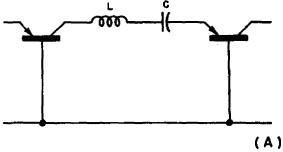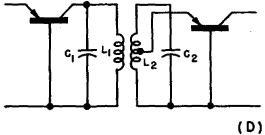| Transistor Basics is a free introductory textbook on transistors and their basic applications. See the editorial for more information.... |

|

Home  Transistor High Frequency Applications Transistor High Frequency Applications  High Frequencies Circuits High Frequencies Circuits  I-F Coupling Circuits I-F Coupling Circuits |
|||






|
|||
|
I-F Coupling CircuitsAuthor: Leonard Krugman
For interstage coupling, an i-f transistor amplifier may use a series resonant circuit such as that illustrated in Fig. 7-5 (A). The "main requirement for this type of coupling is that the short-circuit current gain is greater than unity. Thus, the series connection in the case of the junction type may only be used in the grounded emitter connection. Parallel-tuned resonant-coupling circuits are applicable in i-f strips, particularly when junction transistors are used. If point-contact transistors are used, special care is required to avoid oscillation due to the inherent instability of these types when short circuited. Several types of parallel-tuned coupling circuits may be employed. Figure 7-5 (B) illustrates one such possible circuit with the input of the coupled stage directly connected into the resonant circuit of the first stage. This direct coupling can also be used if the inductor and capacitor are interchanged. Figure 7-5 (C) illustrates another coupling arrangement with the input of the second stage connected to the junction of the two capacitors in the resonant output tank of the first stage. In this case, the capacitors can be used for matching the impedances between the stages. This coupling arrangement can be made inductive by reversing the reactive elements and connecting the input of the second stage into the tank inductance. This arrangement requires that a capacitor be inserted in the input lead of the second stage. This capacitor blocks the d-c bias and also helps to avoid the excessive loading of the tank due to the input circuit of the second stage. An alternate method is to couple the second stage to the tank inductively. If the inductive coupling is also tuned in the second stage, the circuit becomes the double-tuned coupling network illustrated in Fig. 7-5 (D). The center tap in the inductance of the secondary circuit provides for the proper impedance match between the stages.
|
|||
Home  Transistor High Frequency Applications Transistor High Frequency Applications  High Frequencies Circuits High Frequencies Circuits  I-F Coupling Circuits I-F Coupling Circuits |
|||
Last Update: 2007-03-21





